Vincent Ginis
Michael Pokorny
How Deep Do Large Language Models Internalize Scientific Literature and Citation Practices?
Apr 03, 2025
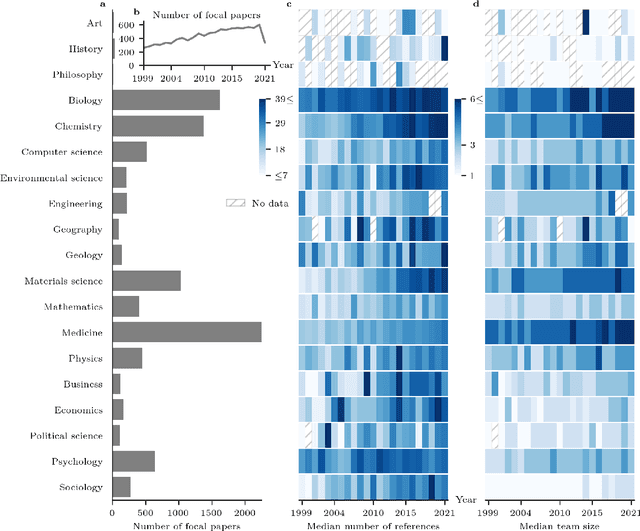
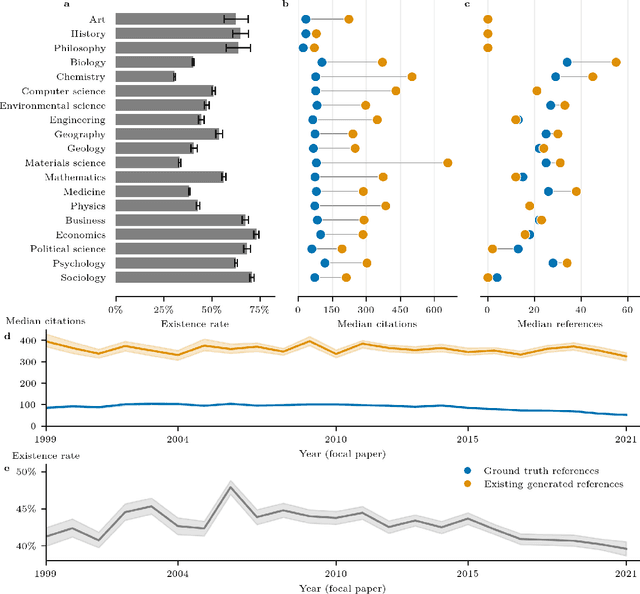
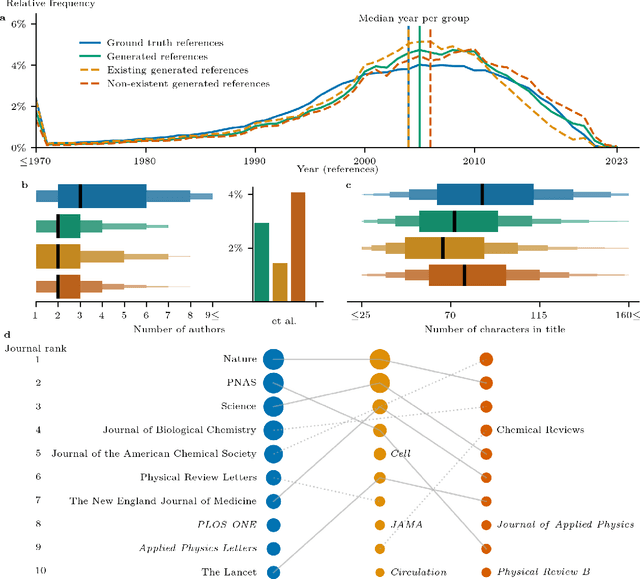
Abstract:The spread of scientific knowledge depends on how researchers discover and cite previous work. The adoption of large language models (LLMs) in the scientific research process introduces a new layer to these citation practices. However, it remains unclear to what extent LLMs align with human citation practices, how they perform across domains, and may influence citation dynamics. Here, we show that LLMs systematically reinforce the Matthew effect in citations by consistently favoring highly cited papers when generating references. This pattern persists across scientific domains despite significant field-specific variations in existence rates, which refer to the proportion of generated references that match existing records in external bibliometric databases. Analyzing 274,951 references generated by GPT-4o for 10,000 papers, we find that LLM recommendations diverge from traditional citation patterns by preferring more recent references with shorter titles and fewer authors. Emphasizing their content-level relevance, the generated references are semantically aligned with the content of each paper at levels comparable to the ground truth references and display similar network effects while reducing author self-citations. These findings illustrate how LLMs may reshape citation practices and influence the trajectory of scientific discovery by reflecting and amplifying established trends. As LLMs become more integrated into the scientific research process, it is important to understand their role in shaping how scientific communities discover and build upon prior work.
Flexible Counterfactual Explanations with Generative Models
Feb 24, 2025
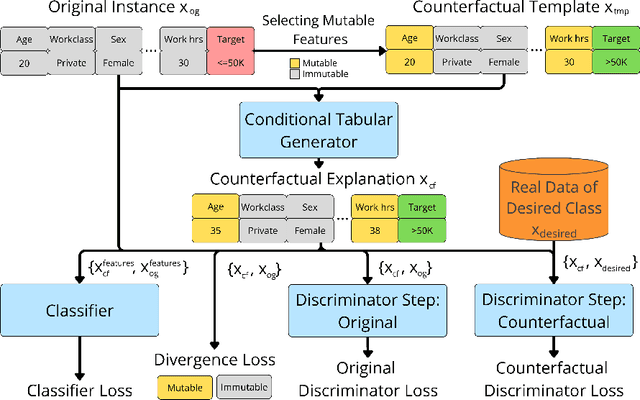
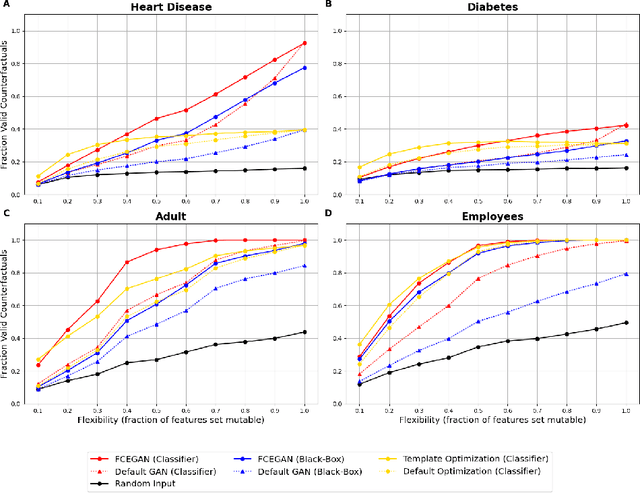
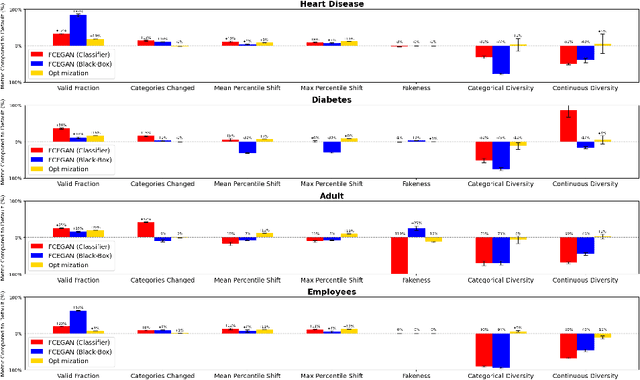
Abstract:Counterfactual explanations provide actionable insights to achieve desired outcomes by suggesting minimal changes to input features. However, existing methods rely on fixed sets of mutable features, which makes counterfactual explanations inflexible for users with heterogeneous real-world constraints. Here, we introduce Flexible Counterfactual Explanations, a framework incorporating counterfactual templates, which allows users to dynamically specify mutable features at inference time. In our implementation, we use Generative Adversarial Networks (FCEGAN), which align explanations with user-defined constraints without requiring model retraining or additional optimization. Furthermore, FCEGAN is designed for black-box scenarios, leveraging historical prediction datasets to generate explanations without direct access to model internals. Experiments across economic and healthcare datasets demonstrate that FCEGAN significantly improves counterfactual explanations' validity compared to traditional benchmark methods. By integrating user-driven flexibility and black-box compatibility, counterfactual templates support personalized explanations tailored to user constraints.
The Relationship Between Reasoning and Performance in Large Language Models -- o3 (mini) Thinks Harder, Not Longer
Feb 21, 2025Abstract:Large language models have demonstrated remarkable progress in mathematical reasoning, leveraging chain-of-thought and test-time compute scaling. However, many open questions remain regarding the interplay between reasoning token usage and accuracy gains. In particular, when comparing models across generations, it is unclear whether improved performance results from longer reasoning chains or more efficient reasoning. We systematically analyze chain-of-thought length across o1-mini and o3-mini variants on the Omni-MATH benchmark, finding that o3-mini (m) achieves superior accuracy without requiring longer reasoning chains than o1-mini. Moreover, we show that accuracy generally declines as reasoning chains grow across all models and compute settings, even when controlling for difficulty of the questions. This accuracy drop is significantly smaller in more proficient models, suggesting that new generations of reasoning models use test-time compute more effectively. Finally, we highlight that while o3-mini (h) achieves a marginal accuracy gain over o3-mini (m), it does so by allocating substantially more reasoning tokens across all problems, even the ones that o3-mini (m) can already solve. These findings provide new insights into the relationship between model capability and reasoning length, with implications for efficiency, scaling, and evaluation methodologies.
Humanity's Last Exam
Jan 24, 2025Abstract:Benchmarks are important tools for tracking the rapid advancements in large language model (LLM) capabilities. However, benchmarks are not keeping pace in difficulty: LLMs now achieve over 90\% accuracy on popular benchmarks like MMLU, limiting informed measurement of state-of-the-art LLM capabilities. In response, we introduce Humanity's Last Exam (HLE), a multi-modal benchmark at the frontier of human knowledge, designed to be the final closed-ended academic benchmark of its kind with broad subject coverage. HLE consists of 3,000 questions across dozens of subjects, including mathematics, humanities, and the natural sciences. HLE is developed globally by subject-matter experts and consists of multiple-choice and short-answer questions suitable for automated grading. Each question has a known solution that is unambiguous and easily verifiable, but cannot be quickly answered via internet retrieval. State-of-the-art LLMs demonstrate low accuracy and calibration on HLE, highlighting a significant gap between current LLM capabilities and the expert human frontier on closed-ended academic questions. To inform research and policymaking upon a clear understanding of model capabilities, we publicly release HLE at https://lastexam.ai.
Early evidence of how LLMs outperform traditional systems on OCR/HTR tasks for historical records
Jan 20, 2025Abstract:We explore the ability of two LLMs -- GPT-4o and Claude Sonnet 3.5 -- to transcribe historical handwritten documents in a tabular format and compare their performance to traditional OCR/HTR systems: EasyOCR, Keras, Pytesseract, and TrOCR. Considering the tabular form of the data, two types of experiments are executed: one where the images are split line by line and the other where the entire scan is used as input. Based on CER and BLEU, we demonstrate that LLMs outperform the conventional OCR/HTR methods. Moreover, we also compare the evaluated CER and BLEU scores to human evaluations to better judge the outputs of whole-scan experiments and understand influential factors for CER and BLEU. Combining judgments from all the evaluation metrics, we conclude that two-shot GPT-4o for line-by-line images and two-shot Claude Sonnet 3.5 for whole-scan images yield the transcriptions of the historical records most similar to the ground truth.
The Effectiveness of Curvature-Based Rewiring and the Role of Hyperparameters in GNNs Revisited
Jul 12, 2024Abstract:Message passing is the dominant paradigm in Graph Neural Networks (GNNs). The efficiency of message passing, however, can be limited by the topology of the graph. This happens when information is lost during propagation due to being oversquashed when travelling through bottlenecks. To remedy this, recent efforts have focused on graph rewiring techniques, which disconnect the input graph originating from the data and the computational graph, on which message passing is performed. A prominent approach for this is to use discrete graph curvature measures, of which several variants have been proposed, to identify and rewire around bottlenecks, facilitating information propagation. While oversquashing has been demonstrated in synthetic datasets, in this work we reevaluate the performance gains that curvature-based rewiring brings to real-world datasets. We show that in these datasets, edges selected during the rewiring process are not in line with theoretical criteria identifying bottlenecks. This implies they do not necessarily oversquash information during message passing. Subsequently, we demonstrate that SOTA accuracies on these datasets are outliers originating from sweeps of hyperparameters -- both the ones for training and dedicated ones related to the rewiring algorithm -- instead of consistent performance gains. In conclusion, our analysis nuances the effectiveness of curvature-based rewiring in real-world datasets and brings a new perspective on the methods to evaluate GNN accuracy improvements.
Large Language Models Reflect Human Citation Patterns with a Heightened Citation Bias
May 29, 2024Abstract:Citation practices are crucial in shaping the structure of scientific knowledge, yet they are often influenced by contemporary norms and biases. The emergence of Large Language Models (LLMs) like GPT-4 introduces a new dynamic to these practices. Interestingly, the characteristics and potential biases of references recommended by LLMs that entirely rely on their parametric knowledge, and not on search or retrieval-augmented generation, remain unexplored. Here, we analyze these characteristics in an experiment using a dataset of 166 papers from AAAI, NeurIPS, ICML, and ICLR, published after GPT-4's knowledge cut-off date, encompassing 3,066 references in total. In our experiment, GPT-4 was tasked with suggesting scholarly references for the anonymized in-text citations within these papers. Our findings reveal a remarkable similarity between human and LLM citation patterns, but with a more pronounced high citation bias in GPT-4, which persists even after controlling for publication year, title length, number of authors, and venue. Additionally, we observe a large consistency between the characteristics of GPT-4's existing and non-existent generated references, indicating the model's internalization of citation patterns. By analyzing citation graphs, we show that the references recommended by GPT-4 are embedded in the relevant citation context, suggesting an even deeper conceptual internalization of the citation networks. While LLMs can aid in citation generation, they may also amplify existing biases and introduce new ones, potentially skewing scientific knowledge dissemination. Our results underscore the need for identifying the model's biases and for developing balanced methods to interact with LLMs in general.
LUCID-GAN: Conditional Generative Models to Locate Unfairness
Jul 28, 2023Abstract:Most group fairness notions detect unethical biases by computing statistical parity metrics on a model's output. However, this approach suffers from several shortcomings, such as philosophical disagreement, mutual incompatibility, and lack of interpretability. These shortcomings have spurred the research on complementary bias detection methods that offer additional transparency into the sources of discrimination and are agnostic towards an a priori decision on the definition of fairness and choice of protected features. A recent proposal in this direction is LUCID (Locating Unfairness through Canonical Inverse Design), where canonical sets are generated by performing gradient descent on the input space, revealing a model's desired input given a preferred output. This information about the model's mechanisms, i.e., which feature values are essential to obtain specific outputs, allows exposing potential unethical biases in its internal logic. Here, we present LUCID-GAN, which generates canonical inputs via a conditional generative model instead of gradient-based inverse design. LUCID-GAN has several benefits, including that it applies to non-differentiable models, ensures that canonical sets consist of realistic inputs, and allows to assess proxy and intersectional discrimination. We empirically evaluate LUCID-GAN on the UCI Adult and COMPAS data sets and show that it allows for detecting unethical biases in black-box models without requiring access to the training data.
Linear CNNs Discover the Statistical Structure of the Dataset Using Only the Most Dominant Frequencies
Mar 03, 2023Abstract:Our theoretical understanding of the inner workings of general convolutional neural networks (CNN) is limited. We here present a new stepping stone towards such understanding in the form of a theory of learning in linear CNNs. By analyzing the gradient descent equations, we discover that using convolutions leads to a mismatch between the dataset structure and the network structure. We show that linear CNNs discover the statistical structure of the dataset with non-linear, stage-like transitions, and that the speed of discovery changes depending on this structural mismatch. Moreover, we find that the mismatch lies at the heart of what we call the 'dominant frequency bias', where linear CNNs arrive at these discoveries using only the dominant frequencies of the different structural parts present in the dataset. Our findings can help explain several characteristics of general CNNs, such as their shortcut learning and their tendency to rely on texture instead of shape.
LUCID: Exposing Algorithmic Bias through Inverse Design
Aug 26, 2022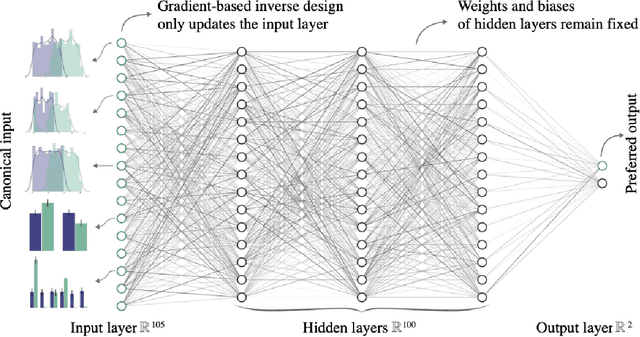

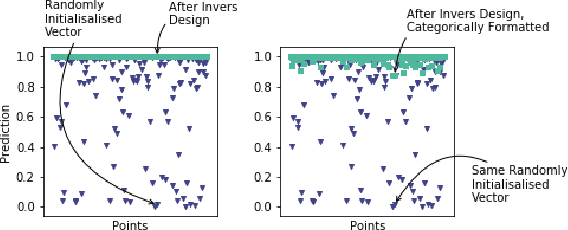

Abstract:AI systems can create, propagate, support, and automate bias in decision-making processes. To mitigate biased decisions, we both need to understand the origin of the bias and define what it means for an algorithm to make fair decisions. Most group fairness notions assess a model's equality of outcome by computing statistical metrics on the outputs. We argue that these output metrics encounter intrinsic obstacles and present a complementary approach that aligns with the increasing focus on equality of treatment. By Locating Unfairness through Canonical Inverse Design (LUCID), we generate a canonical set that shows the desired inputs for a model given a preferred output. The canonical set reveals the model's internal logic and exposes potential unethical biases by repeatedly interrogating the decision-making process. We evaluate LUCID on the UCI Adult and COMPAS data sets and find that some biases detected by a canonical set differ from those of output metrics. The results show that by shifting the focus towards equality of treatment and looking into the algorithm's internal workings, the canonical sets are a valuable addition to the toolbox of algorithmic fairness evaluation.
 Add to Chrome
Add to Chrome Add to Firefox
Add to Firefox Add to Edge
Add to Edge